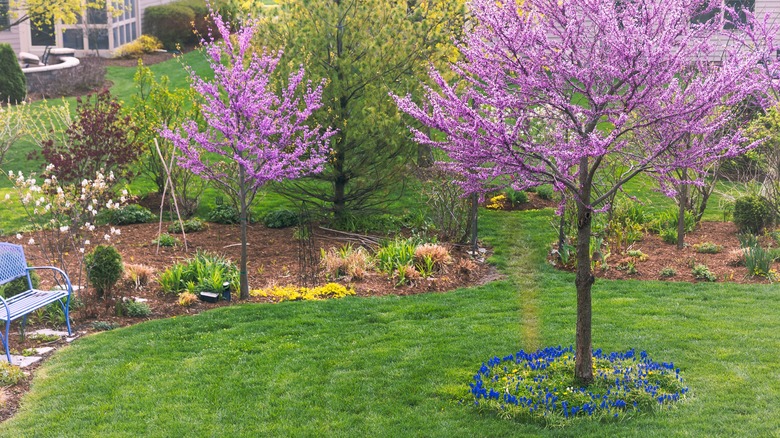These Unique Rainbow Trees Are Stunning, But You Shouldn't Plant Them In Your Yard
Imagine this: the beauty of a tree with bark that appears to be a living canvas, splashed with all sorts of vibrant shades from green to blue and orange to purple. Meet the rainbow eucalyptus or Eucalyptus deglupta, a true wonder of nature indigenous to the Philippines, Indonesia, and Papua New Guinea that is bound to add drama to any yard. This tropical beauty thrives in warm, humid climates and requires moist soil with great drainage. It can reach staggering heights of over 200 feet in its native environment, making it the tallest eucalyptus species on the planet. But it's the unique, smooth rainbow-colored bark that makes this tree stand out and why so many homeowners want to add it to their space.
Now, as tempting as it may be to marvel at its spectacle from your very own backyard, the tree has one major drawback — it is considered an invasive plant species in certain regions, including parts of the United States. With its rapid growth rate and ability to dominate landscapes, it can quickly outcompete native flora, disrupting local ecosystems.
So, before you take the vibrant plunge, it's crucial to consult with your local cooperative extension to ascertain whether introducing this dramatic species is allowed. Planting it irresponsibly comes with the risk of being required to cut it down, and given its bespoke appeal, the rainbow eucalyptus is not a cheap investment. Be prudent and protect both your pocketbook and the surrounding ecosystems by verifying local regulations before planting.
What can you plant instead of the rainbow eucalyptus?
The first contender for rainbow eucalyptus alternative is the coral tree or Erythrina variegata which has striking coral-red blossoms and low maintenance requirements. These trees bloom in the spring and summer and are great at attracting all sorts of pollinators. They can be grown in zones 10 and up, thrive in full sun, and require well-drained soil for a full growth of 35 to 40 feet.
The Eastern Redbud, or Cercis canadensis, is a native alternative, boasting vibrant pink to purplish blooms that bring stunning color to spring landscapes. Ideal for USDA zones 4 through 9, the redbud thrives in full sun to partial shade and adapts to various soil types, from clay to sandy loam, as long as it drains well. This tree appreciates consistent moisture but can withstand brief periods of drought once established. Compact yet striking, the eastern redbud adds color without being a risk to native species.
For something a bit more exotic, you might consider growing the Chinese fringe tree, aka Chionanthus retusus, which grows easily in zones 5 through 9. During late spring, this tree blooms with clusters of wispy, fringelike flowers that emit a sweet fragrance. It's relatively compact compared to the towering rainbow eucalyptus, making it ideal for smaller yards, and prefers full sun to partial shade with occasional watering. No matter which you choose, each of these stunning alternatives brings its own unique aesthetic to your outdoor space while fitting responsibly within local ecosystems.

